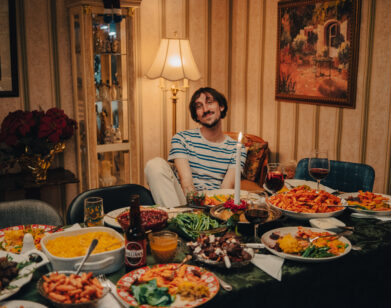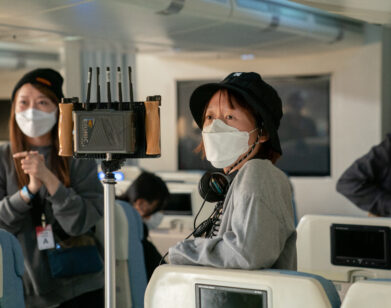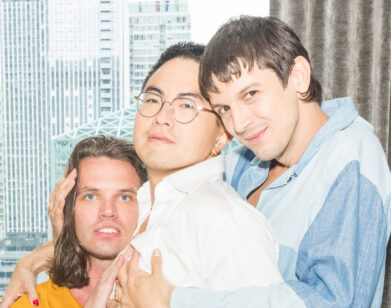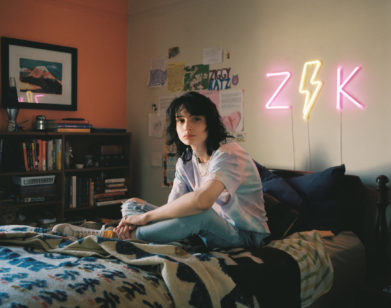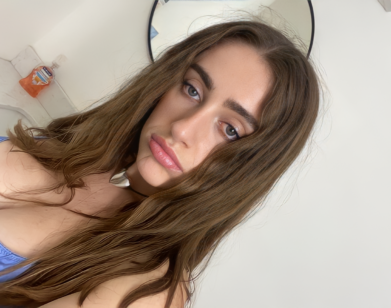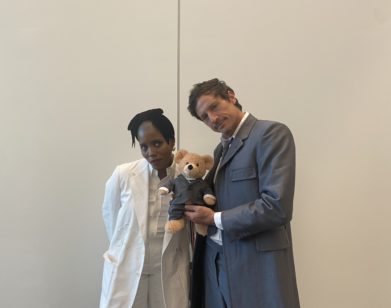IN CONVERSATION
For Jane Schoenbrun And Richard Kelly, Making Movies Is a Religious Experience
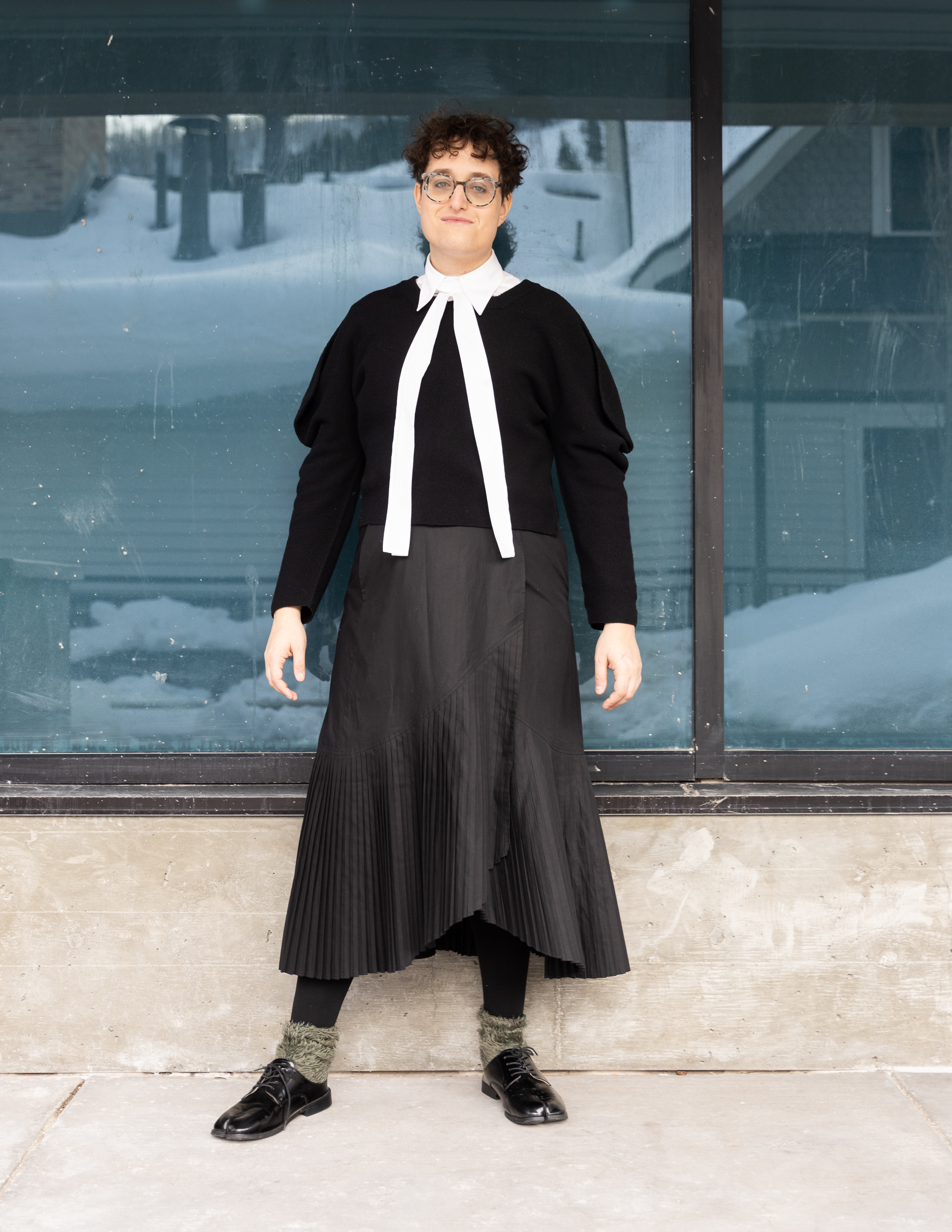
Jane Schoenbrun, photographed by Myles Pettengill.
Since its premiere at Sundance earlier this year, the nostalgic thriller I Saw The TV Glow has been enthusiastically hailed as Gen Z’s Donnie Darko. Director Jane Schoenbrun’s third feature takes a hazy trip back to the 90’s, where a pair of teen outcasts, stuck in the clutches of a suffocating suburban youth, take solace in a supernatural television show that soon becomes a point of obsession. But once the show is abruptly cancelled, it becomes clear the show wasn’t merely entertainment, but a vehicle through which the duo were able to process their own questions of gender and identity. This experience of self-discovery through media is near and dear to Schoenbrun, who saw in the film an opportunity to plumb the depths of their own suburban upbringing, as they told Donnie Darko director Richard Kelly on a Zoom call last month. “I had this recurring dream while I was working on the movie about this weird overgrown field behind the football field at my high school,” Schoenbrun explained. “And this became a metaphor for what I was looking for.” In conversation, the two talked about avoiding cliched depictions of the suburbs, their peculiar connections to the Clintons, and making movies in a time of “Marvel hegemony.”
———
JANE SCHOENBRUN: I want to start by saying that this is such an honor. I am a big fan, going all the way back to renting Donnie Darko from my childhood video store probably eight or nine times in the course of a year. But I’m sure you’re pseudo-aware that over the last few years in the New York “film Twitter” world, there’s been such an embrace of Southland Tales and The Box. I’m such a huge fan of all three of your films and the way that you did some crazy shit with other people’s money back then. It’s going to be hard for me not to just ask you questions this whole time.
KELLY: Thank you so much. I’ve been working away diligently and continuing in my quest to make those kinds of movies. There are a lot of roadblocks and obstacles, but I forge ahead and try to stick to who I am. I wish I could have made more films, but I’m really excited about what the future holds.
SCHOENBRUN: Absolutely. I’ve always had this instinct of, I would rather not make a movie than make something that I didn’t really care about. Do you share that same feeling? ‘Cause I certainly see in the work that it feels like you’re incapable of not going to the places that you want to go.
KELLY: Yes, I absolutely have this feeling and it’s something that came from my childhood. My parents put me in art class when I was five years old. Since the beginning of my career as an artist, I have always viewed this as almost a religious experience. Getting to direct a film is such a privilege and a luxury. It’s as if my church is being on a movie set. Because I directed my first film when I was barely 25 years old, it set this tone for me that everything has to meet an emotional standard for me to care. I don’t want to ever be operating on a level of indifference. If you’re that kind of person who really is in this for more spiritual reasons, not really saying that like I’m a particularly religious person, but more—
SCHOENBRUN: No, I know exactly what you mean. You’re doing it because you need to.
KELLY: Yeah. I was talking about the suburbs recently because I’ve been spending a lot of time back in Virginia where I grew up. There is something in your film I Saw the TV Glow, which I have now seen twice, that really gets into suburbs and recreating elements of childhood with allegory and celluloid and actors, and that’s a deeply emotional thing to do. You’ve done it in a really beautiful way. Is there something specific that triggered this screenplay from your childhood in—was it Northern Long Island?
SCHOENBRUN: Westchester, New York. The other side of the New York City suburbs. Yeah, I knew that it was going to be a movie excavating my suburban childhood. I’m suspicious of movies about the suburbs generally because at this point, it feels like an impression of J.J. Abrams doing an impression of Steven Spielberg. It’s so well-worn that it almost feels like to fall back on the tropes of the suburbs is to already lose the battle of conjuring something out of the genuine memory onto the screen. So much of my early work in this film was moving past those bled-dry cliches of the remembered suburbs of the ’90s and trying to find these kernels that were existing behind it. I had this recurring dream while I was working on the movie about this weird overgrown field behind the football field at my high school, and this became a metaphor for what I was looking for. So in the film, something like how election night at the high school felt when I was still in elementary school and my mom would take me to vote with her on those little lever machines…. to find these things and bring them back with me from memory to the screen, that was the goal.
KELLY: Yeah. That was a very specific question I wanted to ask you. In the beginning of your film, Owen’s mother, played by Danielle Deadwyler, takes him to the high school and brings him into one of those old-school voting machines from the ’90s. This would’ve been 1996, during the reelection of Bill Clinton. There’s a moment where I was trying to make out what she says to Owen inside the voter’s booth, because it feels as though she’s going to let him vote for her?
SCHOENBRUN: The idea is that she’s going to try to pick him up and he’s going to pull the lever for Clinton, and she says to him, “Don’t you want to vote for the saxophone man again?” Bill Clinton wasn’t the neoliberal, don’t ask, don’t tell, world market guy. He’s just the guy who played saxophone.
KELLY: A funny story, when we were shooting Donnie Darko in the year 2000, this was a mere four years after the election that you’re describing, and Bill Clinton was still President of the United States. It was 2000, and we were heading into a very pivotal election that fall. I remember Jake [Gyllenhaal], who grew up in L.A., had befriended Chelsea Clinton. Here I was trying to direct my first movie, and my lead actor was literally hanging out with Chelsea Clinton.
SCHOENBRUN: Wow. That same year, I would’ve been 13 years old, and now it would be a bat, but at the time it was a Bar Mitzvah. My Bar Mitzvah was at some Hilton Garden Inn and in the middle of the party, the Secret Service showed up because Hillary was on the premises ’cause they were from Westchester. I literally took the camcorder and went chasing after her with the fucking camera that they were using to commemorate my bar mitzvah. So the Clintons weren’t far from either of us.
KELLY: It’s interesting how our lives are shaped in so many ways by these elections. I used to be very cynical about the idea of a presidential election when I was much younger and felt that it was meaningless. But looking back, they were these benchmarks in our youth, and each election is like a domino and to the next one.
SCHOENBRUN: Yeah, that’s in your work. The thing I love about Southland Tales is how prescient it feels about that domino effect, the way you’re capturing this post-9/11 Iraq War clusterfuck that George W. Bush is dancing into with a dumb grin on his face. But it’s not just about George W. Bush and the specifics of the political situation in Iraq, it’s also about the way that the media was intersecting with this never-ending war of our culture, one it feels like we’re mired in even more in the Trump era.
KELLY: Yeah. It feels like the inflammation continues. There’s this dial and they just keep turning it up. Whether it’s for ratings or for clicks or ad revenue, it’s very alarming. I feel like the more art that can be a political exploration, or like a soothing, calming tonic coming from a voice that we don’t normally see, the better. That’s one of the reasons why I so enjoyed watching your film. In getting this project off the ground, you had the wonderful experience of getting Emma Stone and her company [Fruit Tree] involved in producing your movie. I’m sure that must’ve been an incredible thing.
SCHOENBRUN: Well, I don’t think We’re All Going to the World’s Fair, my first film, made a margin of the impact that Donnie Darko did. But I made it for no money, and it premiered at Sundance and slowly became this cult object. I worked in film for 10 years before I started making my own, and I’d seen so many filmmakers try to make something cool. The landscape is so conservative in terms of what you’re allowed to do with film language as a first-time filmmaker. Once there’s other people’s money involved, it’s pretty limiting. Bringing on Fruit Tree was this process of growing up and being like, “I need some adults in the room who are like-minded, who help me jump a couple rungs up on the ladder.”
KELLY: Yeah. Also, the visual language of your movie is so intricate and there’s so many different visual layers that you are exploring, from makeup to prosthetic effects to all of these different set pieces. Do you storyboard and use concept art, or is it something that you discovered along the way?
SCHOENBRUN: At this point, most of it is in the screenplay. I’ve learned to do a shot list while writing a screenplay, and that’ll get rewritten and expanded a million times over. With this film, I begged my producers to give me a little bit of money before we were officially green-lit so I could go work with a friend who’s an illustrator. I brought him 25 frames that I wanted us to paint together. We made these Photoshop collages that we then turned into animated images that were a handful of the most ambitious key frames in the movie. Having the resources to take those ideas and transform them into hand-drawn images and then transform them into reality was one of the coolest parts of the process. All of the best films are creating these little worlds. They’re not trying to replicate reality, they’re trying to break reality in beautiful ways. So many of my favorite films also feel like they’re animated, even if they’re live action, like Blade Runner, or your films. They feel so rich and otherworldly with the intentionality that had to have been created with as much dedication that would go into animation.
KELLY: Yeah. Also, you shot 35mm film on this film, and it’s very clear watching it that there is this analog quality that is blended with the VHS feeling of all of these clips that you recreate from The Pink Opaque, which is the television show that the characters in your film are obsessively following. You fall through these analog layers and that is a very fitting mechanism for all of these different stylistic flourishes that you’re blending together. Was that a difficult battle to fight to get to shoot 35mm?
SCHOENBRUN: It was, yeah. When you’re shooting digital, it feels disposable somehow, and you have to find a way to make it holy. But also, the analog stuff was such a fun part of the post-production process. We canned the 35mm print and then output to VHS and then output to Beta and then rescanned that. Some of the shots in the movie are layering all three formats on top of each other, and then it’s all blended together to create these images that we had such precision over. It was like, “Oh, I want the kid in bed’s face to be 25, ’cause I really want to see his expression, but I need the background to be VHS to give that haze. I want the bedsheets to be Beta ’cause I want to see some of the detail there.” I’m curious, now we’re talking about process and seeing what you can create on a computer, have you ever flirted with the idea of just getting a camcorder and making something with no budget?
KELLY: I have been so focused on putting together these really ambitious movies and writing and writing and writing, there’s a lot of layers to what I’m doing, and there’s a lot of stuff that I am working on that exists in the digital animation space. It’s almost like I’m building these Russian nesting doll works of art. There’s parts of at least one of my new projects where I’ve already created a lot of the smaller nesting dolls, but I need someone to come in and really pay for the big nesting doll, you know what I mean?
SCHOENBRUN: For something like Southland Tales, do you feel like that movie is the big nesting doll or is it one of the small nesting dolls?
KELLY: Well, Southland Tales is still unfinished. I’m still beating the drum to try and do that one day. I joked that I’m going to be in the Academy old folks home finishing Southland Tales—
SCHOENBRUN: Finishing the special effects in the film?
KELLY: Well, with sock puppets, talking to myself. That’s a big complicated thing and it involves money and a lot of cast members. I’ve also been waiting for the technology to catch up in terms of licensing.
SCHOENBRUN: Do you mean finish the movie itself or continue and expand the story into other work?
KELLY: To me, it’s all one and the same. I’m hoping to expand and realize the full six chapters and the graphic novel. We’ll see. I’m going to keep banging the drum.
SCHOENBRUN: I do the same nesting doll activity. My reps were initially like, “You’re making this movie about television, think about television.” But I don’t really watch television anymore because it feels so terrifying to imagine spending a year or two making a pilot and then it never gets picked up. And if it does, you’re telling half a story. So after I finished I Saw the TV Glow, I disappeared for a year and wrote the first of three novels that I planned to write. To bring it back to the nesting doll stuff, it was something to put on the page that I still would love to bring to the screen. But it was this mama bird protective impulse of, I don’t believe that anyone is going to let me do anything like this without them ruining it, and I need to protect the vision of it and put it into some form that can exist after I die. It speaks to this spiritual calling that you’re talking about, which is this fierce belief that the work itself can’t be corrupted or polluted.
KELLY: Yeah. I’ve written a lot of TV for a lot of studios and the myriad of projects I’ve been working on, but the idea of actually directing a pilot that’s very personal to you, that then just gets thrown on the scrap heap of 10,000 pilots that are never seen or heard from again, that would be very heartbreaking for me. I’m sure in TV, when you put all this effort into a pilot and then there’s a regime change at a network or a streamer, or because of an algorithm decide that they’re just going to trash it and bury it—
SCHOENBRUN: That’s happening with movies now, right?
KELLY: Oh, yeah. Well, getting back to I Saw the TV Glow, which is opening this evening in New York and L.A. from the wonderful A24, this has to be just a really exciting moment for you. I hope that you’re enjoying it. This is my last question, what message would you like people to take from the film more than anything?
SCHOENBRUN: Well, this film is deeply personal. The film is about gender transition and queerness and reassessing my own childhood and sense of home in the immediate aftermath of my egg-crack and the beginning of transition. Trans is one of my pieces of self-identity that I cling to, and artist is another one. All of these things that we’re talking about are very near and dear to me and certainly to the film as well. Not only because it’s a film about media and the roles that it plays in our creation of self, but because I care so deeply about that experience as I was the beneficiary of music and videotapes. Your own film meant something to me growing up, and made me feel a little less lonely. I want to make that kind of work, and that work by its nature has something that capital can’t do on its own. I remember going to some pitch fest with a friend and it was right after Donald Glover had premiered Atlanta, and he was like, “Everyone is telling me they want the new Atlanta, but I know that if I had brought them Atlanta before Atlanta, they would’ve said no.” Everyone is always operating with this lowest common denominator fear when, actually, the thing that leads to something being lasting and impactful is… the risk can’t be mitigated. I hope that my film can serve as an example, not just to people in my community making more honest work as trans folks, but as proof in the last gasps of the Marvel hegemony that we can make some really cool, new, personal things if artists were trusted a little bit more to do that. Yourself included, Richard.
KELLY: That is a very wonderful and articulate way of saying that there is, I believe, always going to be a place for personal art somewhere outside of the rule of the algorithm. An algorithm ultimately can’t create something that is lasting. It can only try to plagiarize things. Plagiarism always gets exposed in the end. There’s always going to be room for original work, and we can always borrow from our influences.
SCHOENBRUN: Just watching your three films that you’ve made to date and being very excited for the next one, that trajectory has meant a lot to me, as does seeing somebody fight to make three masterworks through that system. So, thank you for those movies.
KELLY: Thank you very much, Jane. I look forward to many, many more films from you.

